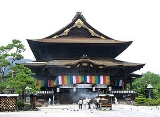
Zenko-ji
Encyclopedia

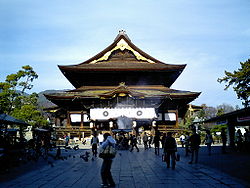
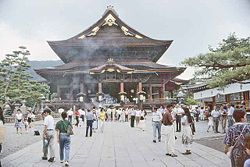
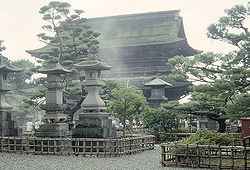
Buddhism
Buddhism is a religion and philosophy encompassing a variety of traditions, beliefs and practices, largely based on teachings attributed to Siddhartha Gautama, commonly known as the Buddha . The Buddha lived and taught in the northeastern Indian subcontinent some time between the 6th and 4th...
temple located in Nagano
Nagano, Nagano
, the capital city of Nagano Prefecture, is located in the northern part of the prefecture near the confluence of the Chikuma and the Sai rivers, on the main Japanese island of Honshū.As of April 1, 2011 the city has a population of 387,146...
, Japan
Japan
Japan is an island nation in East Asia. Located in the Pacific Ocean, it lies to the east of the Sea of Japan, China, North Korea, South Korea and Russia, stretching from the Sea of Okhotsk in the north to the East China Sea and Taiwan in the south...
. The temple was built in the 7th century. Nagano City, established in 1897, was originally a town built around the temple. Historically, Zenkō-ji is perhaps most famous for its involvement in the battles between Uesugi Kenshin
Uesugi Kenshin
was a daimyo who ruled Echigo province in the Sengoku period of Japan.He was one of the most powerful lords of the Sengoku period. While chiefly remembered for his prowess on the battlefield, Kenshin is also regarded as an extremely skillful administrator who fostered the growth of local industries...
and Takeda Shingen
Takeda Shingen
, of Kai Province, was a preeminent daimyo in feudal Japan with exceptional military prestige in the late stage of the Sengoku period.-Name:Shingen was called "Tarō" or "Katsuchiyo" during his childhood...
in the 16th century, when it served as one of Kenshin's bases of operations. Currently, Zenkō-ji is one of the last few remaining pilgrimage sites in Japan.
Zenkō-ji was founded before Buddhism
Buddhism
Buddhism is a religion and philosophy encompassing a variety of traditions, beliefs and practices, largely based on teachings attributed to Siddhartha Gautama, commonly known as the Buddha . The Buddha lived and taught in the northeastern Indian subcontinent some time between the 6th and 4th...
in Japan was split into several different sects, so it currently belongs to both the Tendai
Tendai
is a Japanese school of Mahayana Buddhism, a descendant of the Chinese Tiantai or Lotus Sutra school.Chappell frames the relevance of Tendai for a universal Buddhism:- History :...
and Jōdoshū
Jodo Shu
, also known as Jōdo Buddhism, is a branch of Pure Land Buddhism derived from the teachings of the Japanese ex-Tendai monk Hōnen. It was established in 1175 and is the most widely practiced branch of Buddhism in Japan, along with Jōdo Shinshū....
schools of Buddhism, and is co-managed by twenty-five priests from the former school, and fourteen from the latter. The temple enshrines images of the Amida Buddha
Amitabha
Amitābha is a celestial buddha described in the scriptures of the Mahāyāna school of Buddhism...
. According to legend, the image, having caused dispute between two clans, was dumped into a canal. It was later rescued by Yoshimitsu Honda. The temple was thus named "Zenkō," according to the Chinese transliteration of Yoshimitsu's name.
The main Buddhist image is a hibutsu (secret Buddha), a hidden Buddha statue, not shown to the public. This hibutsu is rumored to be the first Buddha statue to ever be brought to Japan. The commandments of the temple require the absolute secrecy of the statue, prohibiting it to be shown to anyone, including the chief priest of the temple. However, a replica of the statue (Maedachi Honzon) has been created which can be shown publicly once every six years in spring, in a ceremony called Gokaichō. This event attracts many worshipers and visitors. When the statue was on display in 2003, Zenkō-ji cooperated with Motozenkō-ji and Zenkō-ji of Kofu, Yamanashi Prefecture
Yamanashi Prefecture
is a prefecture of Japan located in the Chūbu region of the island of Honshū. The capital is the city of Kōfu.-Pre-history to the 14th century:People have been living in the Yamanashi area for about 30,000 years...
. The most recent display of "Maedachi Honzon" took place in April and May, 2009.
The temple contains a statue of Binzuru, a physician who was said to be Buddha's follower. Visitors to the temple touch the statue in order to cure their ailments. The temple also contains an inner prayer chamber, accessible to visitors. Currently, a daily morning ritual is held there by the high priest or priestess. From the inner chamber, a narrow staircase leads down to a completely dark corridor. In this corridor worshippers try to touch a metal key hanging on the wall, in order to gain enlightenment. The key represents the Key to the Western Paradise of the Amida Buddha.
History
According to the explanation of Zenkō-ji, The Hibutsu, or the Main Image of Zenkō-ji, moved from India to Japan by way of the Korean peninsula, in the 6th century, during the reign of Emperor KimmeiEmperor Kimmei
was the 29th emperor of Japan, according to the traditional order of succession.His reign is said to have spanned the years from 539 through 571.-Traditional narrative:...
. Afterwards, it was moved several times before coming to rest at its present location in Nagano city.
At the end of the Kamakura period
Kamakura period
The is a period of Japanese history that marks the governance by the Kamakura Shogunate, officially established in 1192 in Kamakura by the first shogun Minamoto no Yoritomo....
(1185–1333), many temples copied Zenkō-ji's famous Buddha statue, and many new temples were built around the country, calling themselves "Zenkō-ji" or "Shin-Zenkō-ji" (The New Zenkō-ji).
In the Sengoku period
Sengoku period
The or Warring States period in Japanese history was a time of social upheaval, political intrigue, and nearly constant military conflict that lasted roughly from the middle of the 15th century to the beginning of the 17th century. The name "Sengoku" was adopted by Japanese historians in reference...
(mid-15th to 17th century), when the Zenkō-ji became embroiled in the struggles between Uesugi Kenshin
Uesugi Kenshin
was a daimyo who ruled Echigo province in the Sengoku period of Japan.He was one of the most powerful lords of the Sengoku period. While chiefly remembered for his prowess on the battlefield, Kenshin is also regarded as an extremely skillful administrator who fostered the growth of local industries...
and Takeda Shingen
Takeda Shingen
, of Kai Province, was a preeminent daimyo in feudal Japan with exceptional military prestige in the late stage of the Sengoku period.-Name:Shingen was called "Tarō" or "Katsuchiyo" during his childhood...
, the chief abbot was afraid it would be burnt to the ground. He built a new Zenkō-ji in what is now Kofu
Kofu, Yamanashi
is the capital city of Yamanashi Prefecture in Japan.As of May 1, 2011, the city had a estimate population of 197,540, with 85,794 households. The total area is 212.41 km².-History:Kōfu's name means "capital of Kai Province"...
; it stands to this day.
In 1598, Toyotomi Hideyoshi
Toyotomi Hideyoshi
was a daimyo warrior, general and politician of the Sengoku period. He unified the political factions of Japan. He succeeded his former liege lord, Oda Nobunaga, and brought an end to the Sengoku period. The period of his rule is often called the Momoyama period, named after Hideyoshi's castle...
moved the hibutsu to Kyoto
Kyoto
is a city in the central part of the island of Honshū, Japan. It has a population close to 1.5 million. Formerly the imperial capital of Japan, it is now the capital of Kyoto Prefecture, as well as a major part of the Osaka-Kobe-Kyoto metropolitan area.-History:...
, and then to Shinano
Shinano, Nagano
is a town located in Kamiminochi District, Nagano, Japan.As of 2005, the town has an estimated population of 9,851 and a density of 65.99 persons per km². The total area is 149.27 km²....
. The hibutsu and the Zenkoji temple itself have since been moved back to Nagano.
Zenkō-ji temple decided to pull out of the 2008 Summer Olympics torch relay, in relation with the 2008 Tibetan unrest
2008 Tibetan unrest
The 2008 Tibetan unrest, also known from its Chinese name as the 3•14 Riots, was a series of riots, protests, and demonstrations that started in Tibetan regional capital of Lhasa and spread to other Tibetan areas and a number of monasteries including outside the Tibet Autonomous Region...
and in solidarity with the Tibetan buddhists. The Zenkō-ji temple was then vandalized.
Inside the compound

Shichidō garan
is a Japanese Buddhist term indicating the seven halls composing the ideal Buddhist temple compound. This compound word is composed by the word , literally meaning "seven halls", and , meaning "temple". The term is often shortened to just garan. To which seven halls the term refers to varies, and...
contains many interesting and historically significant buildings. The compound is arranged in a linear fashion, from the south to the north, so that worshipers and visitors would likely see the buildings in this order. Admission to most of the buildings at the compound is covered by a ticket which costs ¥500. The ticket can be re-used at different buildings.
Daihongan
Immediately on the left, from the southern entrance, this Jōdo Sect temple houses the nunnery and the residence of the high priestess.Niōmon
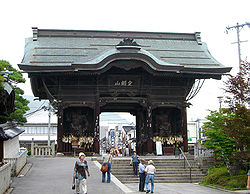

Niōmon
The is the Japanese name of a Buddhist temple gate guarded by two wooden warriors called Niō . The gate is called Heng Ha Er Jiang in China and Geumgangmun in Korea. The two statues are inside the two posts of the gate itself, one at the left, one at the right...
gate features two impressive Niō
Nio
Kongōrikishi or Niō are two wrath-filled and muscular guardians of the Buddha, standing today at the entrance of many Buddhist temples in China, Japan and Korea in the form of frightening wrestler-like statues. They are manifestations of the Bodhisattva ' protector deity and are part of the...
guardians, which protect the compound from enemies of Buddhism. The two statues were reconstructed in 1918 after a fire.
Original Main Hall
The original Main HallMain Hall (Japanese Buddhism)
Main hall is the term used in English for the building within a Japanese Buddhist temple compound which enshrines the main object of veneration. Because the various denominations deliberately use different terms, this single English term translates several Japanese words, among them Butsuden,...
is located on the left, after the Niōmon
Niōmon
The is the Japanese name of a Buddhist temple gate guarded by two wooden warriors called Niō . The gate is called Heng Ha Er Jiang in China and Geumgangmun in Korea. The two statues are inside the two posts of the gate itself, one at the left, one at the right...
gate.
Daikanjin
Located on the left, after the original Main Hall site, this Tendai Sect temple houses the residence of the chief priest. The temple's compound contains a garden and a treasure house, which contains the illustrated scroll of The Tale of GenjiThe Tale of Genji
is a classic work of Japanese literature attributed to the Japanese noblewoman Murasaki Shikibu in the early 11th century, around the peak of the Heian period. It is sometimes called the world's first novel, the first modern novel, the first psychological novel or the first novel still to be...
. Unfortunately, these areas are not open for public viewing.
Rokujizō

Sanmon


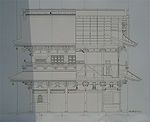
Sanmon
A , also called is the most important gate of a Japanese Zen Buddhist temple, and is part of the Zen shichidō garan, the group of buildings that forms the heart of a Zen Buddhist temple. It can be however often found in temples of other denominations too...
Gate is considered an Important Cultural Property
Important Cultural Properties of Japan
The term is often shortened into just are items officially already classified as Tangible Cultural Properties of Japan by the Japanese Agency for Cultural Affairs and judged to be of particular importance to the Japanese people....
. It contains five wooden Buddhist statues (not available for public viewing), as well as a plaque with calligraphy by the Imperial prince, which is said to contain five hidden doves in the lettering. Reconstruction of the Sanmon Gate began on October 1, 2002 and was scheduled to end on December 31, 2007.
Kyōzō
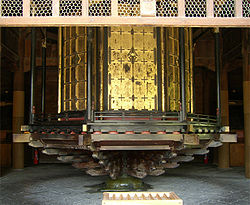
Kyōzō
in Japanese Buddhist architecture is a repository for sūtras and chronicles of the temple history. It is also called , , or . In ancient times the kyōzō was placed opposite the belfry on the east-west axis of the temple. The earliest extant kyōzō is at Hōryū-ji, and it is a two-storied structure....
is located on the far left from the Sanmon Gate. It is also an Important Cultural Property. The building contains a repository of printed Buddhist sutras
Sutra
Sūtra is an aphorism or a collection of such aphorisms in the form of a manual. Literally it means a thread or line that holds things together and is derived from the verbal root siv-, meaning to sew , as does the medical term...
, and visitors get to rotate the octagonal sūtra
Sutra
Sūtra is an aphorism or a collection of such aphorisms in the form of a manual. Literally it means a thread or line that holds things together and is derived from the verbal root siv-, meaning to sew , as does the medical term...
holder, in order to gain enlightenment. The Kyōzō
Kyōzō
in Japanese Buddhist architecture is a repository for sūtras and chronicles of the temple history. It is also called , , or . In ancient times the kyōzō was placed opposite the belfry on the east-west axis of the temple. The earliest extant kyōzō is at Hōryū-ji, and it is a two-storied structure....
was constructed in 1759, although the sūtra holder was made in 1694.
Zenkō-ji Hon-dō

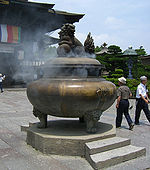
Main Hall (Japanese Buddhism)
Main hall is the term used in English for the building within a Japanese Buddhist temple compound which enshrines the main object of veneration. Because the various denominations deliberately use different terms, this single English term translates several Japanese words, among them Butsuden,...
, located at the northern end of the compound. It is considered a National Treasure.
External links
- Zenkō-ji Official Site (Japanese)
- Yamasa Institute Multimedia Studio This is an excellent overview of Zenkō-ji, with many good photographs.
- Zenkō-ji Kamikaze Special Attack Corps Monument

